Masao Adachi
Johannes Schonherr
Dreams of revolution on all levels of society were ripe in the 1960’s all over the world and filmmakers were often a driving force in challenging the status quo. But probably no other film director went as far to the extremes and, eventually, the outer fringes of the leftist movement as Japanese director and screen-writer Masao Adachi.
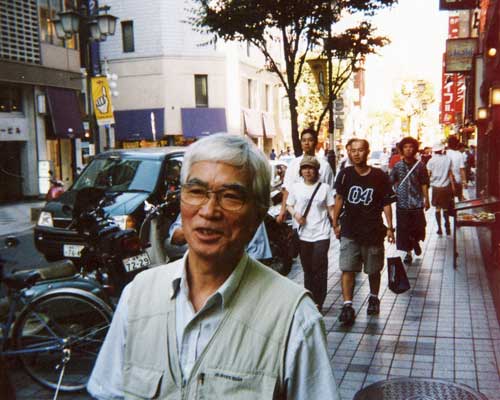
From avant-garde artist to pink filmer to soldier in the Japanese Red Army, battling in the streets of Beirut, Adachi went through an amazing gamut of radical arts and activities – creating some astonishing movies on the way.
Born in 1939 in the industrial town of Kitakyushu on the northern tip of Kyushu, Adachi grew up as the youngest of nine children in the family of a steel-mill worker. His father died before Adachi entered primary school and the family was poor. However, ambitious Adachi made his way into prestigious Nihon University in Tokyo in 1959. It was a rebellious time in Japan, not only on university campuses.
A renewal of the 1951 U.S. – Japan Security Treaty, known in Japan in short as Anpo, was scheduled and a large variety of young leftist groups were vehemently protesting it. The protests turned violent when student activists stormed Haneda Airport in an effort to stop Prime Minister Nobusuke Kishi from flying to the U.S. to sign the renewed treaty. Kishi boarded his plane, a female protester was killed in the turmoil – and the protest movement soon lost its steam.
This defeat left its mark on many of the activists involved, including Adachi. What especially riled them was that the traditional left, namely the Communist Party of Japan, had withdrawn their support once the student action had turned radical. They felt betrayed and bitter and looked for other avenues to express their dissent.
There was no way to do it politically anymore at the time – Japan was in a rush preparing for the 1964 Tokyo Olympics and the student radicals soon found themselves pushed to the margins.
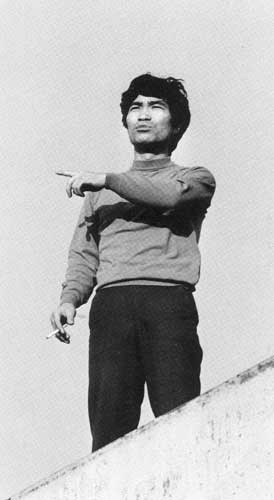
Experimental Movies and VAN
The arts still offered a certain degree of freedom. After his first and enigmatic experimental film Rice Bowl(1961), in which Adachi expressed his disappointment with the failure of the protests in rather abstract terms, Adachi became part of VAN, a sort of loose anarchist artist group which operated a large studio in Tokyo.
By 1963, regular performances of avant-garde happenings took place at the studio, painters exhibited their pictures, film shows were held, concerts played. It became one of the hot spots of the Tokyo art world with people like Yoko Ono, experimental filmmaker Takahiko Iimura and especially film director and theater group leader Shuji Terayama in regular attendance. Even John Cage came over from New York for a series of concerts.
Pink Movies
In about 1964, a new genre entered Japan’s cinema screens: pink films, low-budget sex films which showed breasts, buttocks and simulated intercourse but no genitals and no pubic hair. In terms of content, everything was permitted, from sexually deviant behavior to sexual violence and, by the end of the decade, political radicalism. Pink movies gave a whole generation of Japanese film directors a fast, hands-on start of their careers.
One of those young auteurs was Koji Wakamatsu, who had created a big scandal at the Berlin Film Festival in 1965 with his pink entry Secret Act Inside Walls. The Japanese government had tried to stop the screening but the festival organizers went ahead with it anyway.
Back in Japan, Wakamatsu opened his own independent film studio, Wakamatsu Productions. Adachi was introduced to Wakamatsu by one of his VAN collaborators and soon joined the studio, at first as screenplay writer, later as director.
The first film Wakamatsu based on an Adachi script was The Embryo Hunts in Secret (1966), a dark, brooding drama on a pervert who holds a girl hostage, rapes and tortures her. Adachi’s first film as director for Wakamatsu was Birth Control Revolution (1967), centered on a sadistic doctor who believes that torture keeps girls from getting pregnant.
Both Wakamatsu and Adachi were politically on the left and as the decade progressed and a new generation of student protestors went out into the streets, they linked their films to the new movement. Though rape and torture remained hallmarks of their films, they now added street battles, bombings and Vietnam War references to their repertoire.
At the same time, Adachi took up working as screen writer for another legend of Japanese cinema, Nagisa Oshima. It was Adachi who wrote the script for one of Oshima’s most famous films, the Shinjuku subculture / student revolution themed Diary of a Shinjuku Thief (1969).
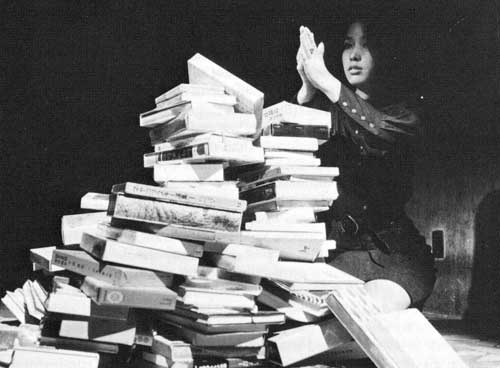
Middle East
In May 1971, Wakamatsu, Adachi and Oshima went together to the Cannes Film Festival to present a series of their works. They had sold-out shows, the French press praised their films, old VAN acquaintance Yoko Ono invited them to parties where they enjoyed the high life with Ono’s husband, a certain John Lennon.
But Wakamatsu and Adachi had more ambitious plans. On their way back from Cannes, they flew to the Lebanon with the intention to make a documentary about the Palestinian struggle.
Looking for contacts, the Japanese embassy in Beirut recommended them a young Japanese woman with particularly strong local contacts: Fusako Shigenobu. In fact, Shigenobu was working closely with the Popular Front for the Liberation of Palestine, a Marxist terrorist group especially known for their hijackings and she had started out her own terrorist outfit, the Lebanon-based Japanese Red Army (Sekigun).
Shigenobu enabled Wakamatsu and Adachi to interview notorious hijackers like Leila Khaled, they got access to PFLP training camps and propaganda sessions.
Once back in Japan, Wakamatsu and Adachi released their Lebanon footage under the title Red Army – PFLP World War Declaration (1971). Since no legitimate theater wanted to play the incendiary propaganda piece prohibited outright by the Japanese government, Adachi traveled around Japan in a red truck, screening the film at university campuses. He took a group of battle-steeled street fighters with him to protect the screenings from interferences by rival factions.
See here Shigenobu talking about her idea of world revolution (footage from Red Army – PFLP)
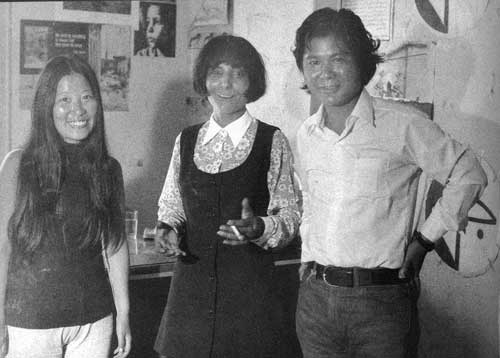
Ecstasy of the Angels
In February 1972, a group of student radicals belonging to the United Red Army (a rival group of Shigenobu’s Red Army) went for an “ideological seminar” into the mountains of Gunma Prefecture. Fifteen of them were murdered during the course of the “seminar” over what their leaders Tsuneo Mori and Hiroko Nagata considered impurities in their ideology.
A small band of survivors escaped and took over a vacation inn in Karuizawa, Nagano Prefecture, named the Asama Sanso after nearby Mount Asama, holding the inn keeper hostage. Known as the Asama Sanso Incident, a 10- day siege of the inn by heavily armed police ensued, broadcast live on TV. Two policemen were killed before the hostage could eventually be freed. The radicals were arrested but soon after were freed after an airplane hijacking.
The murderous “seminar” in Gunma and the Asama Sanso siege threw the entire leftist radical scene in Japan into turmoil and they lost most of their public support.
Adachi reacted to the situation with his perhaps darkest and most nihilistic film, Ecstasy of the Angels (1972). Japanese terrorist groups are at each other’s throats, the revolutionary talk sounds hollow and the movie ends with a desperate but absolutely pointless bombing campaign against pre-Christmas shoppers in Shinjuku. The student movement had reached its bloody end.
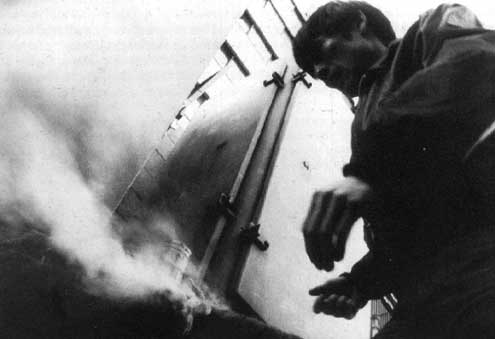
The Lebanon
Frustrated, Adachi packed up and left in 1974 for the Lebanon where he joined Fusako Shigenobu’s Japanese Red Army. Adachi arrived shortly after the Lod Airport massacre in Tel Aviv in 1972, perpetrated by three members of the same Japanese Red Army on orders of the PFLP, leaving 26 people dead.
Adachi maintains that he didn’t participate in any of the later terror attacks of the Japanese Red Army either. He did however participate in the frequent factional shoot outs during the Lebanese Civil War (1975 -1990).
Movie making was out of the question in the Lebanon – the PFLP was not interested in weird, sexually charged Adachi style films. Rather, Adachi was active as supporter, organizer and promoter for the PFLP. That’s what he says today, anyway. He refers to the time as the “years without images.”
By the end of the Civil War, the PFLP had lost much of its popular support and was barely surviving as an organization. Adachi and the other members of the Japanese Red Army in the Lebanon were left with no choice but to hang on to the outdated group. Weak as it was, it was their only protection.
The new Lebanese government however wanted to get rid of the Japanese terrorists. In 1997, the Lebanese authorities arrested Adachi and four other Japanese Red Army members and threw them in jail for 3 years. Adachi shared his cell with Kon Okamoto, the only surviving perpetrator of the 1972 Lod Airport massacre.
Okamoto had spent serious time after the massacre in an Israeli prison before he was released in a prisoner exchange.
Okamoto, a national hero among Palestinians for his airport killings, eventually received asylum in the Lebanon in 2000. Adachi and three other Japanese terrorists were sent back to Japan.
There, Adachi spent another year and a half in prison, on passport violations, as no other charges could be proven in court.
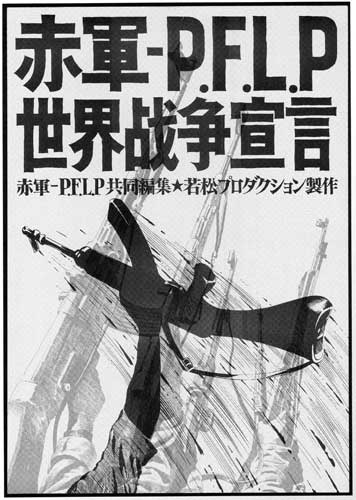
Back in Japan
Once released, Adachi went straight back to Wakamatsu Productions. Wakamatsu took him back in.
Almost nothing was left of the 1960s student revolution movement in Japan. Adachi himself was totally forgotten. But soon, curious film historians connected the dots and began to popularize his pre-Lebanon movie work via books and movie retrospectives.
In 2007, Adachi released the first and so far only movie he directed after his return from the Lebanon, Prisoner / Terrorist. The movie was based on Adachi’s Beirut cell mate Kon Okamoto’s alleged experiences in Israeli prison.
You can watch the Japanese language trailer for the film here on YouTube.
Koji Wakamatsu died in 2012, Fusako Shigenobu was arrested in Osaka in 2000 and sentenced to 20 years prison.
Adachi is still busy today writing movie screenplays and occasionally joining talk events on a small Japanese lecture circuit organized by surviving veterans of a revolution that failed terribly.
Further Reading
Cinema of Actuality: Japanese Avant-Garde Filmmaking in the Season of Image Politics
Politics, Porn and Protest: Japanese Avant-Garde Cinema in the 1960s and 1970s
A New History of Japanese Cinema: A Century of Narrative Film
Eros Plus Massacre: An Introduction to the Japanese New Wave Cinema
Leila Khaled: Fighting for Palestine